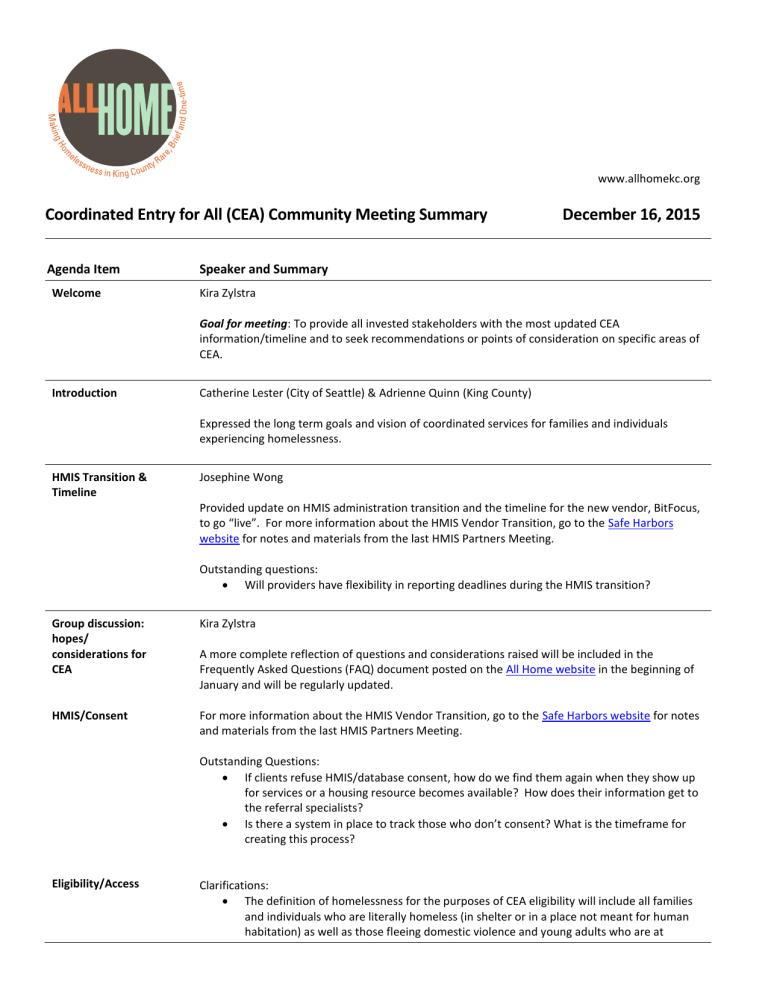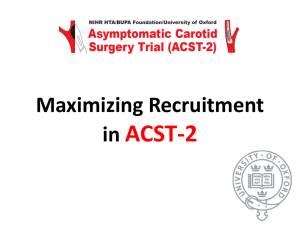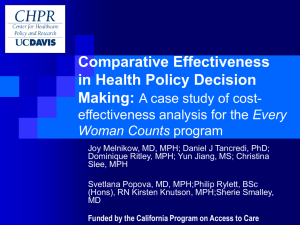CEA Meeting Summary 12-16-2015

www.allhomekc.org
Coordinated Entry for All (CEA) Community Meeting Summary December 16, 2015
Agenda Item Speaker and Summary
Welcome Kira Zylstra
Goal for meeting: To provide all invested stakeholders with the most updated CEA information/timeline and to seek recommendations or points of consideration on specific areas of
CEA.
Introduction
HMIS Transition &
Timeline
Group discussion: hopes/ considerations for
CEA
HMIS/Consent
Eligibility/Access
Catherine Lester (City of Seattle) & Adrienne Quinn (King County)
Expressed the long term goals and vision of coordinated services for families and individuals experiencing homelessness.
Josephine Wong
Provided update on HMIS administration transition and the timeline for the new vendor, BitFocus, to go “live”. For more information about the HMIS Vendor Transition, go to the Safe Harbors website for notes and materials from the last HMIS Partners Meeting.
Outstanding questions:
Will providers have flexibility in reporting deadlines during the HMIS transition?
Kira Zylstra
A more complete reflection of questions and considerations raised will be included in the
Frequently Asked Questions (FAQ) document posted on the All Home website in the beginning of
January and will be regularly updated.
For more information about the HMIS Vendor Transition, go to the Safe Harbors website for notes and materials from the last HMIS Partners Meeting.
Outstanding Questions:
If clients refuse HMIS/database consent, how do we find them again when they show up for services or a housing resource becomes available? How does their information get to the referral specialists?
Is there a system in place to track those who don’t consent? What is the timeframe for creating this process?
Clarifications:
The definition of homelessness for the purposes of CEA eligibility will include all families and individuals who are literally homeless (in shelter or in a place not meant for human habitation) as well as those fleeing domestic violence and young adults who are at
Capacity
Assessment Tool imminent risk of homelessness.
Regional Access Points (HUBs) will be identified and access to CEA will be provided through these regional sites AND through mobile assessment and outreach.
Competitive process will determine the selection of HUBs operated by community-based organizations.
Hopes/Considerations:
Use discounted ticket books or Orca Lift to support people in accessing HUBs.
Transportation needs to be available at the HUB locations.
Utilize natural access points for the clients, so assessment can happen in multiple locations. Eight sites don’t feel like enough and there needs to be regional considerations for HUBs.
Need to integrate technology, especially video conferences including multiple parties
(translators if needed). This might be a solution to avoid bussing to a HUB for services.
Hope that any staff can complete assessments.
Make sure there are non-traditional hours for availability and a capacity to updates information.
Need to ensure HUBs are family friendly for young children.
Outstanding Questions:
How will the system manage the roster? How will we support people who are waiting on the roster, knowing there’s limited capacity?
What does “natural access points mean” and what does this mean for YYA providers currently administering assessments?
Clarifications:
The VI-SPDAT will be utilized as the common vulnerability assessment tool for CEA
Supplemental questions and tailored versions of the VI-SPDAT will be used to adapt the tool to each sub-population.
BitFocus has the functionality to support CEA (enter assessment and scores, automated referrals, and tracking service delivery)
Hopes/Considerations:
Re-assess and re-consider using the VI-SPDAT assessment tool. Other assessment tools are available and successfully being used in the community.
VA agency: Using VI-SPDAT works. Anyone can be trained on it making it a useful assessment tool for mobile sites. Any staff can implement it. No special training needed.
Consider a tool with open ended questions – Yes/No questions poses a risk of people changing answers based on their understanding of the vulnerability score system.
Outstanding Questions:
Is it possible to include points from supplementation questions into vulnerability score?
Clarifications
All Permanent Supportive Housing, Rapid Re-Housing, and Transitional Housing will participate in CEA.
Emergency Shelter for Families will be included in CEA and the CoC will acquire HUD technical assistance to plan for including Emergency Shelter for Singles Adults and Young
Adults in the future to align with HUD guidance.
Hopes/Considerations:
Need to connect agencies with unique resources to support people with higher needs.
Need to improve connections to mainstream resources.
Housing locator function is KEY in successful outcomes for people in rapid rehousing programs.
Client choice/voice
Equity
System
Integration
Supportive
Services
Need the ability to update assessments as new information is learned over time.
Need easier/greater access to emergency shelter.
There is a gap in resources – no one is providing resources BEFORE they enter the system.
Outstanding Questions:
How rapid is Rapid Rehousing in the future vision of Coordinated Entry?
Will there be a way to identify which services are available to people with zero income?
What is the capacity to serve those that don’t fit the definition of “homeless”?
How do we ensure there isn’t bottleneck?
What can we learn from Apple Health outreach regarding ramp up for assessments
?
Hopes/Considerations:
HUBs need to be set up for childcare along with swift supports to connect children with school, transportation and other supportive services.
Documentation gathering will help families and individuals move quickly into shelter or housing. Send all documents together with assessments.
Remember the need for childcare funding – there are a lot of reasons why folks don’t qualify for DSHS/TANF/Working Connections.
Hope DSHS and TANF staff will be available at HUBs to pair with employment staff.
All 16 WorkSource sites could have staff trained in CEA to provide assessments.
Outstanding Question:
Can mental health and chemical dependency services provide staff so their population might use the CEA for referrals to their programs?
Can HUBs provide drug/alcohol treatment?
Hopes/Considerations:
Build empowerment into the process / system!
Talk to people we are here to serve to make sure that coordinated entry for all works.
Clients are afraid to be “pushed out” for not being “vulnerable enough”.
Outstanding Questions:
If a client gets into housing and it’s not working out, how will this be managed?
Hopes/Considerations:
Must consider disproportionality when allocating resources!
Address the “undocumented population” - opportunity to build equity into the system.
The system has to consider power balances.
People accessing CEA need to access services with staff that are trained for cultural sensitivity.
Need to consider the specific needs of seniors and people with disabilities.
Work to have sexually exploited young people (minors, 18-19 years old) seen as domestic violence survivors and get the same services as adult survivors.
Hopes/Considerations:
Hope to relook at contracts (more funding) especially for Youth housing – Currently using the same staffing models that don’t match the reprioritized housing / services for clients.
Would like to see the system design for on-going evaluation with the ability make adjustments as change is identified
Hope for seamless connection for clients who age out of youth programs (24 ½). Transition and integrate clients into adult services.
Outstanding Questions:
How will the launch of CEA be different than the launch for FHC?
What is the messaging for families and individuals in regards to the new system and in regards to assessment and current placement rosters?
Is there a way to build technology to “match” client with housing resource?
How do we ensure all resources will be utilized (in the case when you can’t get in touch with the next eligible person or when resources are refused)?
Next Steps
All Home staff will create a CEA page on the All Home website, including documents from community forums and answers to questions raised today.






